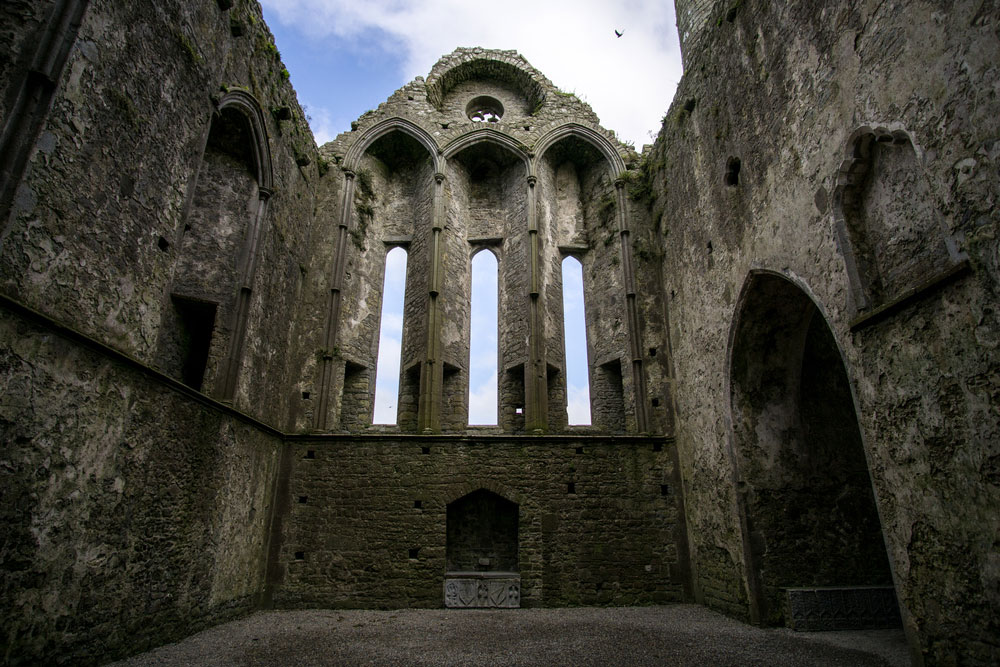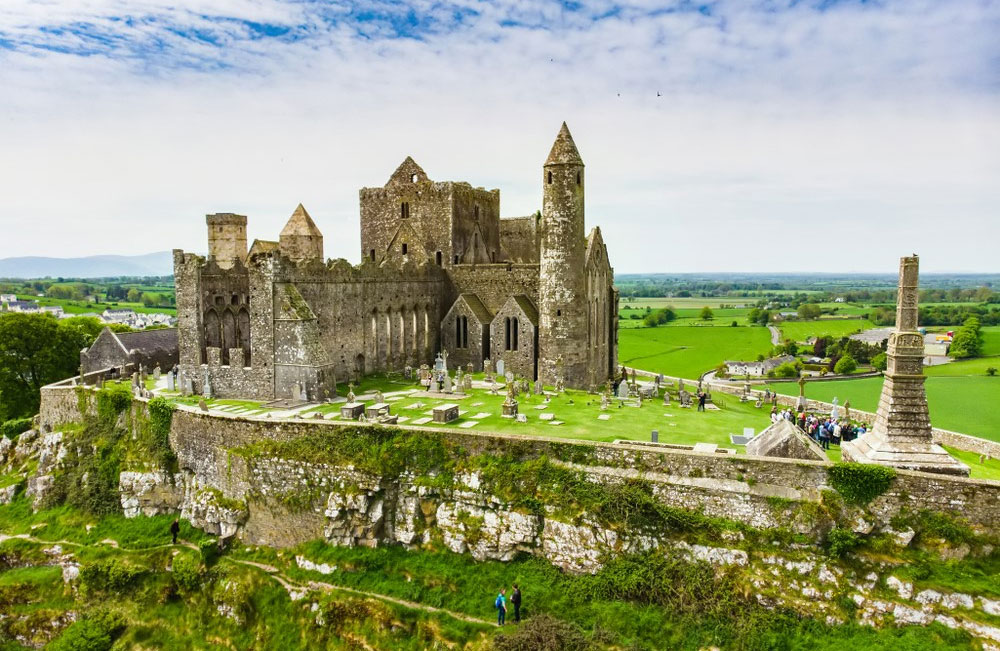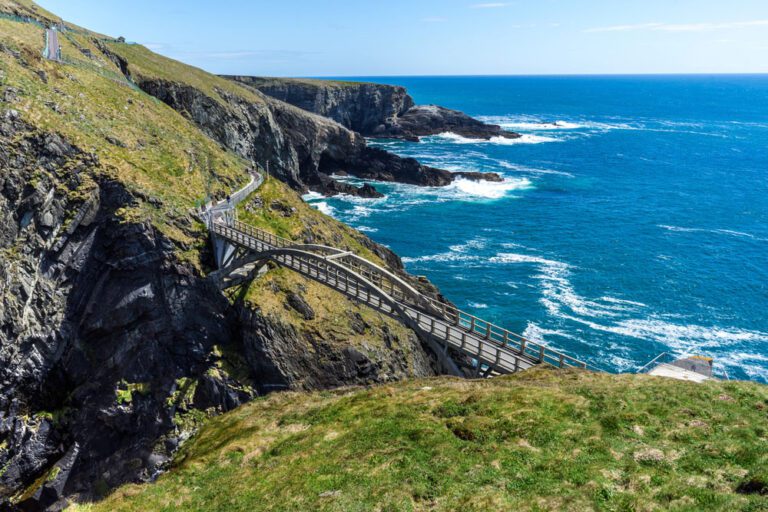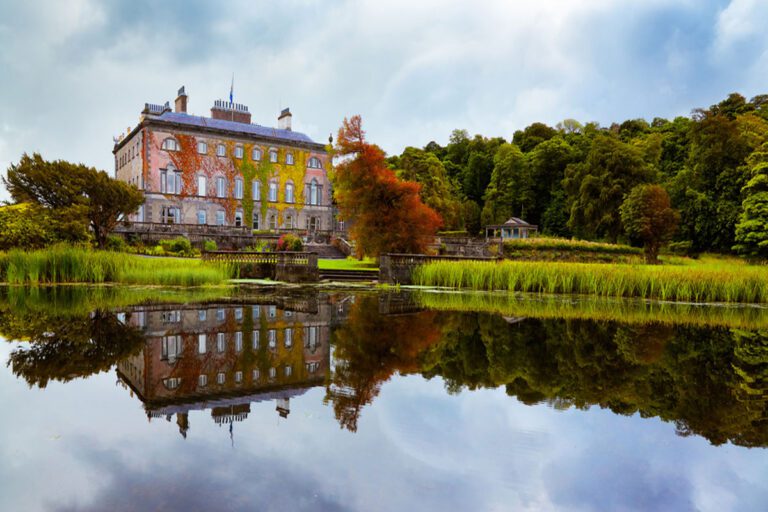History of the Rock of Cashel
The Rock of Cashel is a prehistoric site in County Tipperary. It is said to have been a royal site as early as the fourth century AD, and it has played an important part in Irish history since then. According to legend, St. Patrick converted local King Aengus to Christianity at the Rock of Cashel in the fifth century AD.
The King of Munster handed the Rock of Cashel to the Church in the 12th century, and it became the seat of the archbishopric of Cashel. The church began building a cathedral on the site, which was finished in the 13th century. The cathedral is built in a Romanesque and Gothic style, with spectacular brickwork and beautiful sculptures on the façade and inside.
A circular tower, a chapel, and a bishop’s house were among the prominent structures constructed atop the Rock of Cashel over the ages, in addition to the cathedral.
The Butler family, who seized possession of the Rock of Cashel after the monasteries were disbanded in the 16th century, erected the fortress that exists on the site today in the 15th century.
The Rock of Cashel has seen numerous notable events throughout its history, including the crowning of Brian Boru as High King of Ireland in 1002 AD and the killing of nearly 3,000 people during the Cromwellian invasion of Ireland in 1647. Despite its turbulent past, the Rock of Cashel has remained a symbol of Irish tradition and culture, attracting people from all over the world to marvel at its ancient beauty and rich history.
Architecture of the Rock of Cashel
The Rock of Cashel is an outstanding example of Irish medieval architecture, combining styles and elements from numerous centuries. St. Patrick’s Cathedral, which was finished in the 13th century and features a remarkable combination of Romanesque and Gothic architectural elements, is its most notable structure.
The Romanesque-style characteristics of the cathedral may be observed in the rounded arches that run throughout the construction, as well as the ornate masonry that adorns the façade. The pointed arches of the cathedral’s windows and doors, which were installed during a later refurbishment, also reflect the Gothic design. The inside of the cathedral is similarly spectacular, with soaring ceilings, ornate carvings, and exquisite stained-glass windows.
The circular tower, which dates back to the 12th century and was likely used as a bell tower and a place of shelter during times of invasion, is another prominent feature on the Rock of Cashel. The tower has a conical roof and a portal that is high above the ground and only accessible via ladder.
Cormac’s Chapel, the site’s chapel, was erected in the early 12th century and has stunning Romanesque-style arches and ornamental masonry. The chapel is well-known for its elaborate carvings depicting themes from the Bible and Irish mythology, as well as its stunning chancel screen.
Ultimately, the castle that exists today atop the Rock of Cashel was erected by the Butler family in the 15th century. It incorporates Gothic characteristics such as pointed arches and ornamental masonry, as well as more classic medieval features such as a moat and drawbridge.
The many architectural characteristics on the Rock of Cashel, when combined, give an intriguing glimpse into the history of medieval architecture in Ireland and serve as a tribute to the ability and workmanship of the architects and builders who produced these beautiful constructions.
Lore and legends
The traditions and mythology surrounding the Rock of Cashel have been passed down through the years. The narrative of St. Patrick’s conversion of the local monarch, Aengus, is one of the most renowned traditions related with the Rock of Cashel.
According to tradition, St. Patrick used a shamrock to teach Aengus about the Holy Trinity, and the king was so enthralled that he converted to Christianity on the spot. This incident is reported to have occurred in the fifth century and is regarded as one of the pivotal episodes in the spread of Christianity throughout Ireland.
Another tale surrounding the Rock of Cashel includes the devil himself. According to tradition, the devil was so envious of the beauty of the Rock of Cashel that he sought to steal it for himself. He was frustrated in his attempts, however, by a cunning local woman who persuaded him to halt and relax on a nearby hill. The lady then used a huge boulder to mark the location where the devil had slept, which is still known as the Devil’s Bit today.
Several supernatural phenomena have also been recorded at the Rock of Cashel over the years. There have been claims of ghostly apparitions and unusual noises emanating from the castle, as well as sightings of Saint Patrick himself. Nevertheless, several tourists have observed a powerful spiritual energy or presence, notably in the chapel and cathedral.
These stories and mythology, when combined, add to the mystique and magic of the Rock of Cashel, creating a sense of wonder and awe for visitors. Whether these legends are factual or made up, they serve as a reminder of the profound cultural and spiritual significance that the Rock of Cashel possesses for the people of Ireland.
The Rock of Cashel today
The Rock of Cashel is still one of Ireland’s most famous tourist destinations, attracting people from all over the world. The Office of Public Works has conserved and maintained the property throughout the years, undertaking considerable restoration and conservation work on the many buildings and structures at the site. This restoration has included repairing broken masonry, reinforcing walls and foundations, and installing contemporary conveniences like as lighting and heating.
The Rock of Cashel is now open to tourists all year, with guided tours available for anyone interested in learning more about the site’s history and construction. Visitors may tour the many structures and buildings, such as the cathedral, castle, and round tower, as well as the surrounding grounds and gardens. The property also has a tourist center with exhibits and displays that give further information about the area’s history and culture.
The Rock of Cashel is a significant cultural and historical site in modern Ireland, in addition to being a major tourist destination. The site is widely utilized as a backdrop for cultural events and performances, and it is frequently portrayed as a symbol of Ireland’s rich legacy and history in films, television shows, and other media. The Rock of Cashel is also a popular pilgrimage destination for individuals interested in the area’s religious and spiritual importance, notably its connection to St. Patrick and the early Christian church in Ireland.
Ultimately, the Rock of Cashel exemplifies Ireland’s rich cultural and architectural past, and it continues to captivate visitors and residents alike. Its popularity as a tourist attraction and cultural icon assures that it will continue to be an essential part of Ireland’s identity and history for future generations.
Attractions in the vicinity
The Rock of Cashel is situated in the centre of County Tipperary, surrounded by a variety of other historic and cultural sites worth seeing. Hore Abbey, located just a short distance from the Rock of Cashel, is one of the most visited neighboring locations. This magnificent medieval monastery originates from the 13th century and boasts a plethora of outstanding architectural characteristics, such as elaborate carvings and detailed brickwork.
Another local site is the Cahir Castle, which is located just a few kilometers from the Rock of Cashel. This majestic castle was built in the 13th century and has been successfully kept throughout the years, making it a fascinating destination to visit. Guests may explore the castle’s various chambers and passageways, learning about its history and appreciating its stunning architecture.
Cashel itself is a wonderful resort, with gorgeous streets, cozy pubs, and a wide range of shops and restaurants. Tourists may take a stroll through the town’s historic center, viewing the numerous ancient buildings and taking in the ambiance. In addition, the town is home to a variety of cultural organizations and museums, such as the Cashel Folk Village and the Cashel Heritage Center, which give insights into the region’s rich cultural heritage.
Overall, the region surrounding the Rock of Cashel has a plethora of sights and activities to offer visitors. There is something for everyone in this lovely region of Ireland, whether you are interested in medieval history and architecture or simply soaking up the local culture and environment.

Here are some famous tourist attractions in County Tipperary:
- Cahir Castle: A well-preserved castle that dates back to the 13th century, located on an island in the River Suir in Cahir.
- Swiss Cottage: A picturesque cottage that was built in the early 19th century and is set amidst beautiful gardens and woodlands, located near Cahir.
- Holy Cross Abbey: A historic abbey that was founded in the 12th century and features stunning architecture and artwork, located near Thurles.
- Mitchelstown Cave: A series of limestone caves that are open to the public for guided tours, featuring impressive stalactites and stalagmites, located near Mitchelstown.
- Ormond Castle: A restored 16th-century castle that was built by the powerful Butler family, located in Carrick-on-Suir.
- St. Patrick’s Well: A holy well that is said to have been visited by St. Patrick himself, featuring a natural spring and a series of man-made chambers, located near Clonmel.
- Glen of Aherlow: A scenic valley that offers breathtaking views of the surrounding countryside and is popular for hiking, cycling, and other outdoor activities, located between the Galtee Mountains and the Slievenamuck Ridge.
- Farney Castle: A historic castle that was built in the 15th century and features a restored great hall, a medieval tower, and beautiful gardens, located near Holycross.
- Nenagh Castle: A well-preserved castle that dates back to the 13th century and now houses a heritage center and museum, located in Nenagh.
Helpful Resources: Tipperary Tourist Website




